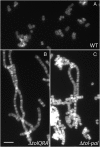The Tol-Pal system is required for peptidoglycan-cleaving enzymes to complete bacterial cell division
- PMID: 32152098
- PMCID: PMC7104345
- DOI: 10.1073/pnas.1919267117
The Tol-Pal system is required for peptidoglycan-cleaving enzymes to complete bacterial cell division
Abstract
Tol-Pal is a multiprotein system present in the envelope of Gram-negative bacteria. Inactivation of this widely conserved machinery compromises the outer membrane (OM) layer of these organisms, resulting in hypersensitivity to many antibiotics. Mutants in the tol-pal locus fail to complete division and form cell chains. This phenotype along with the localization of Tol-Pal components to the cytokinetic ring in Escherichia coli has led to the proposal that the primary function of the system is to promote OM constriction during division. Accordingly, a poorly constricted OM is believed to link the cell chains formed upon Tol-Pal inactivation. However, we show here that cell chains of E. coli tol-pal mutants are connected by an incompletely processed peptidoglycan (PG) layer. Genetic suppressors of this defect were isolated and found to overproduce OM lipoproteins capable of cleaving the glycan strands of PG. Among the factors promoting cell separation in mutant cells was a protein of previously unknown function (YddW), which we have identified as a divisome-localized glycosyl hydrolase that cleaves peptide-free PG glycans. Overall, our results indicate that the cell chaining defect of Tol-Pal mutants cannot simply be interpreted as a defect in OM constriction. Rather, the complex also appears to be required for the activity of several OM-localized enzymes with cell wall remodeling activity. Thus, the Tol-Pal system may play a more general role in coordinating OM invagination with PG remodeling at the division site than previously appreciated.
Keywords: cell wall; colicin; divisome; peptidoglycan.
Conflict of interest statement
The authors declare no competing interest.
Figures





Similar articles
-
The trans-envelope Tol-Pal complex is part of the cell division machinery and required for proper outer-membrane invagination during cell constriction in E. coli.Mol Microbiol. 2007 Feb;63(4):1008-25. doi: 10.1111/j.1365-2958.2006.05571.x. Mol Microbiol. 2007. PMID: 17233825 Free PMC article.
-
NlpD links cell wall remodeling and outer membrane invagination during cytokinesis in Escherichia coli.PLoS Genet. 2017 Jul 14;13(7):e1006888. doi: 10.1371/journal.pgen.1006888. eCollection 2017 Jul. PLoS Genet. 2017. PMID: 28708841 Free PMC article.
-
Genetic interaction mapping highlights key roles of the Tol-Pal complex.Mol Microbiol. 2022 Apr;117(4):921-936. doi: 10.1111/mmi.14882. Epub 2022 Feb 21. Mol Microbiol. 2022. PMID: 35066953
-
The physiology of bacterial cell division.Ann N Y Acad Sci. 2013 Jan;1277:8-28. doi: 10.1111/j.1749-6632.2012.06818.x. Epub 2012 Dec 5. Ann N Y Acad Sci. 2013. PMID: 23215820 Review.
-
The multifarious roles of Tol-Pal in Gram-negative bacteria.FEMS Microbiol Rev. 2020 Jul 1;44(4):490-506. doi: 10.1093/femsre/fuaa018. FEMS Microbiol Rev. 2020. PMID: 32472934 Free PMC article. Review.
Cited by
-
NlpI-Prc Proteolytic Complex Mediates Peptidoglycan Synthesis and Degradation via Regulation of Hydrolases and Synthases in Escherichia coli.Int J Mol Sci. 2023 Nov 15;24(22):16355. doi: 10.3390/ijms242216355. Int J Mol Sci. 2023. PMID: 38003545 Free PMC article.
-
Septal Class A Penicillin-Binding Protein Activity and ld-Transpeptidases Mediate Selection of Colistin-Resistant Lipooligosaccharide-Deficient Acinetobacter baumannii.mBio. 2021 Jan 5;12(1):e02185-20. doi: 10.1128/mBio.02185-20. mBio. 2021. PMID: 33402533 Free PMC article.
-
Peptidoglycan: Structure, Synthesis, and Regulation.EcoSal Plus. 2021 Jan;9(2):eESP-0010-2020. doi: 10.1128/ecosalplus.ESP-0010-2020. EcoSal Plus. 2021. PMID: 33470191 Free PMC article.
-
Third track model for coordination of septal peptidoglycan synthesis and degradation by FtsN in Escherichia coli.Nat Microbiol. 2025 Jun;10(6):1521-1534. doi: 10.1038/s41564-025-02011-w. Epub 2025 May 27. Nat Microbiol. 2025. PMID: 40425829
-
Molecular Characteristics and Quantitative Proteomic Analysis of Klebsiella pneumoniae Strains with Carbapenem and Colistin Resistance.Antibiotics (Basel). 2022 Sep 30;11(10):1341. doi: 10.3390/antibiotics11101341. Antibiotics (Basel). 2022. PMID: 36289999 Free PMC article.
References
-
- Heidrich C., et al. , Involvement of N-acetylmuramyl-L-alanine amidases in cell separation and antibiotic-induced autolysis of Escherichia coli. Mol. Microbiol. 41, 167–178 (2001). - PubMed
-
- Egan A. J. F., Bacterial outer membrane constriction. Mol. Microbiol. 107, 676–687 (2018). - PubMed
-
- Bi E. F., Lutkenhaus J., FtsZ ring structure associated with division in Escherichia coli. Nature 354, 161–164 (1991). - PubMed
Publication types
MeSH terms
Substances
Grants and funding
LinkOut - more resources
Full Text Sources
Other Literature Sources
Molecular Biology Databases

